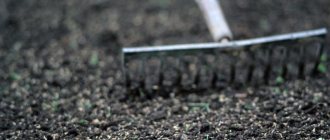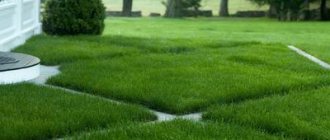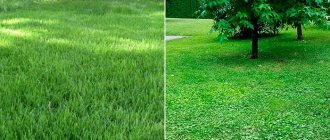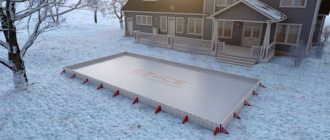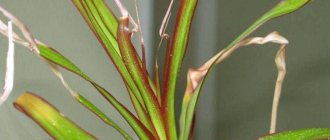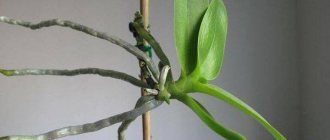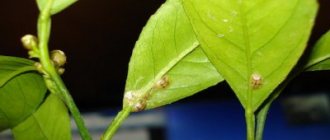We fight weeds on the lawn
Whether you like it or not, weeds will appear on your lawn sooner or later. Therefore, you will have to fight them in any case. True, before declaring war on weeds, you need to figure out what type they are.
The lawn is “illegally” inhabited by two main types of weeds: monocotyledons (wheatgrass, flatweed) and dicotyledons (bindweed, knotweed, plantain, dandelion, buttercup, etc.).
The lesser of two evils is dicotyledonous weeds. Dealing with them is relatively easy. They can be weeded without any problems and are afraid of safe herbicides (which inhibit the growth of weeds without poisoning the lawn grass). Such herbicides include the drugs Dialen, Lintur, Golf.
There is one trick in the fight against these weeds - you can use the “heavy artillery” only after feeding. In order for the herbicide to work, the weed must grow and “gain strength.”
It is worth considering that even the use of even the safest herbicide is a great stress for the lawn. Therefore, after the weeds have died, it is advisable to treat your grass carpet with Megafol, Epin or another anti-stress drug.
The safest way to control weeds is weeding
Getting rid of monocot weeds without damaging your lawn is much more difficult. Of course, you can treat the area with vigorous Roundup or another non-selective herbicide. But in this case, you will have to forget not only about wheatgrass, but also about lawn grass - you will have to lay a rolled lawn or sow the grass again.
Sowing of a new lawn is carried out no earlier than 3-4 weeks after treating the soil with herbicides. This time is necessary for the chemical to completely decompose and for the plants to die.
After treating your lawn with continuous herbicides, you will have to lay down new turf.
Considering all of the above, if you want to preserve your lawn, you will have to rely exclusively on weeding.
Some compromise between the prospect of burning out all living things and allowing weeds to “take over” the entire area of the lawn can be the herbicide Puma Super or Puma Plus. True, it will only be effective for broad-leaved weeds such as flatweed.
Never apply herbicides when the grass is unhealthy or under stress. During droughts, unexpected frosts or flooding of the turf, weeds cannot be eradicated. Let us repeat that before using herbicides it is advisable to feed the lawn with nitrogen fertilizers. For example, a 0.2% solution of ammonium nitrate or urea.
Follow all these recommendations to ensure your lawn always looks well-groomed, thick, and healthy. If you notice that the appearance of your grass has noticeably deteriorated, we advise you to check our list of the 5 most common lawn care mistakes.
Works for every month
An approximate work calendar looks like this:
- March. Comb and aerate the lawn if it has already dried out enough after the snow melts. They prepare and maintain lawn mowers and other mechanized tools - lubricate rubbing parts, sharpen knives, etc.;
- April. Application of fertilizers (feeding). Sowing seeds if irrigation is organized on the site. In April it is already quite warm and young seedlings are not threatened by cold or frost. If there is no irrigation system, it is worth taking a risk and planting the seeds a little earlier, when the soil is still well moistened naturally. At the same time, the seeding rate is increased slightly - in case of death of some of the seedlings;
- May. Lawn mowing. The height of a regular garden lawn is maintained at 5 cm, a parterre lawn - 3 cm. Higher is bad, since broad-leaved grasses choke out narrow-leaved grasses. Below this is also bad, since a plant deprived of a significant part of its leaves does not receive enough substances that it consumes through photosynthesis and cannot adequately supply the root system.
The grass is cut only when it is dry. When wet, it bends, which is why the mowing is carried out incorrectly, and besides, it is not cut, but torn, so that the lawn subsequently takes on a rusty appearance. When mowing, the grass lies in the direction of movement of the knife, so it is useful to change the direction of the lawn mower vector.
They begin cutting when the growth of the grass exceeds the required height by 1.5 cm. If it has grown stronger, the tops are first trimmed and only after 3 days the grass is cut to the desired height. Weeds are also removed in May. There are usually not many of them - weed grass is replaced by lawn grass and suffers from constant cutting. Small areas are weeded by hand, removing the roots of perennial weeds with a spatula or a special tool - a root extractor.
In large areas, weeds are treated with selective herbicides that do not harm lawn grass.
What to do if the grass doesn't grow?
Often gardeners observe a picture when the grass on the lawn grows unevenly, or they simply have to wait a long time for the long-awaited covering. In this case, it is not always justified to blame the quality of the seed material.
You need to analyze all your actions, find mistakes, and try to correct them within a certain time. Seeds may not germinate well due to untimely planting, poor watering and an unprepared area for sowing. The most common reason is the first reason - due to the timing of seed sowing.
It is better to sow lawn areas in early spring or autumn. But during these periods the weather does not always favor plants. So, if the rains are prolonged, or frosts appear on the soil, then you need to wait until the soil dries and use a rake to loosen the compacted soil.
Mulching won't hurt either: if there is no peat, then simply mulch the lawn with loose soil at a level of 1 centimeter. But if extreme heat begins after sowing, you need to water more often and more intensively, up to 2 times a day: early in the morning and in the evening.
In small areas after watering, shelters can be built from the thinnest non-woven material, and to prevent it from being blown away by the wind, it must be secured with weights along the edges.
To learn how to grow a lawn, watch the following video.
Causes of poor grass germination
There are several reasons why grass does not grow well:
- Deep penetration of seeds into the soil. Some varieties of herbal mixture do not have enough strength to germinate.
- The seed material is on the surface. It can be pecked by birds or carried away by the wind.
- Early sowing. If spring frosts return, weak shoots will be destroyed.
- Increased site humidity.
There are a large number of factors that affect the germination of a lawn. Some of them cannot be eliminated by humans, but most depend on the quality of care and planting. Try to choose the right mixture for sowing, and also take into account the growing conditions.
Wrong haircut
When figuring out why the lawn is drying out, analyze its mowing if you have recently done it. It is required throughout the growing season and often ends with the drying out of the green cover. What mistakes are made?
Haircut length
The lawn may turn yellow and dry out due to the wrong cutting length. If you cut off too much green mass, the root system will begin to wither. In this case, you can try fertilizing with any complex fertilizer (from the companies Fertika, Biona, Orgavit) and abundant (but in moderation) watering.
If you trim only the ends, this will lead to excessive thickness and a struggle for survival. In this case, the lawn often dries out in patches. To revive it, it is necessary to urgently remove the length that is recommended for the variety grown on the site, and no longer allow the intensity and density of plantings.
Weather
If your lawn turns yellow after mowing, it is important what the weather was like when you mowed it. If it rains and the grass is wet, the cuts will turn out uneven.
The same thing happens in hot weather. The blades of a mower (garden shears) or trimmer line tear the plant tissue, causing serious damage to it. After them, the green cover begins to dry out and in some places may disappear completely.
What to do: remove brown spots (uproot faded tufts) and reseed bald spots. If the scale of the tragedy is not so great, you can try to get by with feeding. Any complex fertilizer containing potassium, calcium, phosphorus, copper, nitrogen and iron will be suitable.
In the future, to avoid this, for cutting hair in rainy weather you need:
- periodically switch the mower to idle mode (to relieve the load);
- choose the thinnest line of a certain shape for the trimmer - square or star-shaped.
In hot weather, the green coating is not trimmed, otherwise it quickly turns yellow and dries out.
Further care
These are not all the reasons for the lawn drying out after mowing. With subsequent improper care, the consequences will be yellowness and wilting. What errors lead to this:
- If you do not remove the cut green mass after cutting, a felt plug will form, which prevents the plants from developing.
- If you don’t properly water the soil in the evening after mowing (in the absence of precipitation, of course).
- If you do not add fertilizer as support after such a stressful procedure.
- If you run and walk on a freshly mowed area on the same day.
In addition to the above reasons, poorly sharpened tools and untimely mowing (too frequent or vice versa) also lead to the lawn drying out in places immediately after mowing.
Lawn after winter: combing the lawn in spring
How to care for your lawn in spring after winter? If your lawn has dry, yellow leaves and moss in early spring, it's a sign that you're in for some hard work. Before the grass begins to grow intensively, it must be thoroughly combed using the scarification procedure.
Lawn scarification.
It consists of vertically cutting the turf (to a depth of 5-15 mm) and removing moss, grass accumulations, and dry stems that prevent the penetration of air, water and fertilizers to the roots, causing the lawn to weaken and die.
Note! By removing dead debris, there will be free space for new stems to develop. To perform this procedure, use fan and twisted rakes (regular rakes will damage the lawn) or a special scarifier
To perform this procedure, use fan and twisted rakes (regular rakes will damage the lawn) or a special scarifier.
Why are aerators and scarifiers needed: (read more)
Scarification on a small lawn can be done with a special sharp rake.
First, carefully rake out all the lawn felt with a twisted rake, and then “comb” the young grass with a fan, collecting what remains. The remaining small debris is collected with a garden vacuum cleaner or by hand.
Important! Scarify the lawn carefully, first in one direction, then in the opposite direction, forming a “checkerboard” pattern. After the procedure, you need to collect all the remains and add them to the compost, because when decomposed they turn into valuable fertilizer
After the procedure, you need to collect all the remains and add them to the compost, because when decomposed they turn into valuable fertilizer.
Don't worry if your lawn looks worse after scarification, it will recover quickly.
What is compost and a compost bin: (read more)
Helpful advice! On a large lawn (over 100 m2), it is better to use mechanical scarification than manual scarification, because it will require a lot of physical strength and it will be very tiring with your hands!
Very often, concepts such as scarification and verticulation are perceived as synonyms, however, although these procedures are similar, they also have significant differences.
Lawn verticulation: (read more)
Bluegrass
More than 100 species of bluegrass are known in Russia alone. They are often used for arranging sports and decorative lawns; certain species, such as bluegrass, are used to plant the most exquisite parterre lawn coverings.
Bluegrass is a rhizomatous, loose-bush grass. It has a fibrous root system; the roots are located mainly in the upper soil layers. It has dense turf and a thick, beautiful grass carpet of a rich green hue.
This is a winter perennial plant, fully developed by the 3-4th year of life.
Bluegrass Benefits:
- not demanding on soil composition;
- can withstand long periods of flooding;
- resistant to droughts and cold winters;
- They are almost not affected by diseases and infections.
After sowing, single seedlings will appear first, somewhere on the 12-14th day; they sprout en masse only after a month. Three weeks after germination, the bluegrass begins to bush.
We looked at the main lawn grasses, but each of them has many more varieties and varieties, and the germination time for them is individual. When purchasing seeds, this information can be read on the packaging. If you follow the basic rules when arranging the lawn, preparing the soil, and planting seeds, then the grass will sprout according to the time indicated on the package.
What do the shoots look like?
Immediately after emerging from the ground, seedlings begin to quickly develop and increase in size , acquiring the following morphological characteristics:
- Red fescue - seeds take a long time to develop, the first shoots appear after 10 - 13 days, in the form of rare single green arrows. As it develops, a stem is formed, from which 2–3 blades of grass extend.
- Perennial ryegrass - sprouts begin to appear after 2 weeks, in the form of thin tubes, which subsequently increase in diameter and open into full-fledged stems of lawn grass.
- Meadow bluegrass is a perennial plant that fully develops only in the 3rd year of life.
Sprouts appear after 12 days, in the form of even vertical arrows with a height of up to 5 cm. Young plants sprout between the early blades of grass within a week, which gradually cover the lawn with a lush green carpet. - When planting cultivated herbs that produce inflorescences, for example, meadow lavender, 7–15 days after planting, a thin stem with 2–3 rounded leaf blades appears. Such herbs, as a rule, need to be diluted with seeds of other plants.
Many suppliers offer special lawn mixtures of 3 to 5 grasses to customers.
The appearance of seedlings also depends on the type of grass, soil quality and other indirect signs.
Ready mixes
In gardening stores you can often find already prepared mixtures. They include only those varieties that are able to combat unwanted plants. It is worth noting that this option is quite convenient.
After all, it is also important to choose varieties that will be combined with each other, which is quite difficult for a novice gardener
For this reason, it is worth choosing lawn grass against weeds. It includes components that require similar care and also have the same growth cycle. As a rule, any configuration includes bluegrass, fescue and ryegrass. These varieties are used as a base and can be supplemented with various variations.
At the same time, the appearance of the lawn depends on which element will be predominant. So, sets that contain a lot of bluegrass can give the lawn a more saturated dark green color.
The predominance of ryegrass helps create a dense and durable turf layer. It is this that serves as the main protection against unwanted plants.
It is also important to pay attention to the packaging for the mixture, which contains basic information about the product. It is worth choosing products that have been completed recently. In this case, the percentage of sprouted plants will be the highest
In this case, the percentage of sprouted plants will be the highest.
Rules for choosing seeds
The best option when choosing seeds for sowing is to use the same grass mixture that was purchased when forming the lawn.
If there is none, then you should choose one as close as possible to that composition. There are also special repair mixtures of lawn grasses on sale , which contain fast-growing species. When using such herbal mixtures, you need to be prepared for the fact that the growth activity of the new grass will differ from that previously planted.
Such mixtures are suitable for renewing the entire lawn, when the seeds are scattered evenly throughout the entire area. In this case, the grass cover will look even.
How to seed a lawn
The best time to overseed a damaged lawn is spring. But if necessary, you can do this both in summer and autumn.
Before seeding your lawn into bald patches, you need to work with the soil. The piece of turf on which the damaged grass grew is carefully trimmed. The soil is deeply loosened. Loosening should be as deep as possible; special garden tools (rakes, cultivators) are suitable for this.
After all the manipulations, the soil is slightly compacted and the seeds are planted in it. After planting the seeds, they need to be sprinkled with a little soil and compacted.
How to update your lawn urgently
Sod can be replaced. This will require a piece of new turf with healthy grass. Such a piece can be carefully cut off from the edge from an existing one or taken from some other place (buy or ask from neighbors or friends).
Attention! It is important that the piece of new turf is exactly the same size as the old one. For convenience, the area of damaged turf is cut out into a square or rectangle. The soil is loosened, new turf is laid
The cracks on all sides are covered with earth. The new turf is watered daily until it is established.
The soil is loosened and new turf is laid. The cracks on all sides are covered with earth. The new turf is watered daily until it is established.
For convenience, the area of damaged turf is cut out into a square or rectangle. The soil is loosened and new turf is laid. The cracks on all sides are covered with earth. The new sod is watered daily until established.
How to sow grass onto an already growing lawn
If there are places on the lawn where grass rarely grows, you need to reseed them. Bald spots are loosened with a rake to a depth of 2 cm. Next, a mixture of seeds and good, fertile soil is prepared. Take two parts of soil and one part of seeds, mix everything well and evenly place it in the bald spots. After laying, the sown areas are watered with water from a watering can. For two weeks after sowing, the sown areas are irrigated daily.
Grass grows rarely
Gardeners are often interested in how to revive a lawn that has a lot of grass and bald patches? To do this, you will need to perform a set of certain actions, namely, combing, cutting, aerating, digging in places where bald spots are too large and where the grass grows in too thick mounds, applying fertilizers, sowing seeds, and then properly caring for the lawn. All this needs to be done in one season, and next year the lawn will be noticeably transformed.
Step-by-step instruction
The procedure for sowing lawn grass does not depend on the problem itself. If the damage is local and looks like bald spots, then the grass is added to these areas. When the lawn is thinning, when the damaged areas are small but there are many of them, the seeds are scattered throughout the lawn.
Restoration of bald spots is performed as follows::
- lawn grass is being cut;
- all clippings are removed from the lawn;
- in the area to be restored, a layer of turf 5 cm thick is removed;
- the top layer of soil is loosened using a fork or a heavy rake;
- soil containing nitrogen fertilizers is added and leveled using a rake;
- the area is sown with grass seeds, extending beyond its boundaries into undamaged territory;
- lightly walk over fresh crops with a fan rake, sprinkling the seeds with soil;
- the soil in the crop areas is compacted;
- crops are watered.
Every lawn has to be reseeded periodically, as the grass ages and the cover becomes less dense; weeds begin to sprout in thinned areas. If they are not replaced by lawn grass, they will quickly spread throughout the entire area.
If there are a lot of small bald spots on the site, sowing grass throughout the entire lawn is done as follows:
- cut the lawn, leaving the grass up to 4 cm high - this way the old grass will not block the sun for the young shoots;
- Use a fan rake to clear the entire area of dry grass and debris;
- loosen the top layer of soil with a heavy rake or aerate it using a fork, piercing the ground with it to a depth of 8-10 cm;
- adjust the acidity of the soil by adding lime or granulated sulfur, pine needles or peat if necessary;
- add compost, spreading it over the area in a thin layer;
- feed the lawn with nitrogen fertilizers;
- using a seeder or manually scatter grass seeds throughout the area;
- To ensure that the seeds are fixed in the top layer of soil, walk over the lawn with a rake and water it.
Germination time of lawn grass seeds
It is no secret that each plant has its own growth period.
Some herbs sprout in early spring and are pleasing to the eye throughout the summer. Others germinate closer to the warm season, forming lush bright emerald bushes. It is the composition of the grass mixture that will determine how long it takes for lawn grass to sprout. Each mixture presented in our store, as well as single-species grasses, is designed to fill large and small areas. The germination time of lawn seeds depends entirely on its composition - the content and ratio of herbs determines how quickly your lawn will grow. Our blends are made from the following herbs:
Perennial ryegrass. Champion among grasses in terms of growth rate. Germination of lawn grass of this variety under favorable conditions is less than a week. Ryegrass is also not susceptible to many diseases. That is why it makes up most of the mixtures for restoration (for example, “Recultivation”, “Bald spot”). Red fescue. This herb is rightfully considered the most frost-resistant, and therefore is found in almost all mixtures. This variety is ideal for planting in autumn - in early spring you will get a beautiful and even cover without bald spots. Meadow bluegrass. Also refers to winter crops, therefore, if planted in a timely manner in early spring, it appears one of the first
The germination period for lawn seeds of this type is about a week (pay attention to the mixtures “Children’s”, “Summer Resident”, “Old Park”).
All these types of grass have proven their rapid growth and are included in almost all grass mixtures.
At what temperature and other conditions does it grow?
For normal seed germination, the following favorable conditions must be provided::
To plant seeds in spring, it is recommended to maintain the outside air temperature from +10°C and above, and the soil cover from +8°C.- When planting perennial grass in late autumn with the expectation of using the lawn in the spring, the temperature should not exceed +3°C, which prevents rapid germination of seeds and guarantees their safety throughout the winter.
- The soil must contain organic additives and also have the required porosity to allow aeration.
- The soil for planting must have the required amount of nutritious fertilizers, as well as organic fertilizer for the rapid development of plants.
- The moisture level of the soil base should be such that a screwdriver or any other sharp steel rod can freely sink into the ground to a depth of at least 10 - 15 cm.
Regardless of the temperature and humidity conditions for the current day, it is recommended to study the weather forecast before planting in order to exclude the occurrence of recurrent cold at night, which can destroy young shoots.
How to restore your lawn without digging it up
The easiest and fastest way to restore your lawn is to lay down a piece of new lawn with finished turf and green growing grass on it. First you need to cut out a section of the old lawn along with the turf.
Popular articles How to properly clean a pond with copper sulfate
Restore your lawn without digging it up
How to renew your lawn without digging up the old one? There are 2 ways to restore a lawn with bald spots without digging up the soil:
- The first method involves cutting out the damaged piece along with the turf. The earth is mixed with sand and placed in a hole. Sow seeds, dig them in with soil, and water them.
- The second method is simpler, but does not guarantee 100% survival and good germination. A piece of bald spot is well trimmed and combed out. Soil mixed with sand is placed on top of the turf, then seeds are sown, which are lightly sprinkled with soil. Everything is compacted and watered.
To ensure that the lawn sown in the fall still takes root and is not eaten by birds or destroyed by frost, you can cover the restored areas with peat mixed with sand or compost for the winter.
If bald spots are discovered, there is no need to delay reseeding, because the sooner all defects are eliminated, the faster the lawn will acquire a decorative appearance. To prevent bare areas from appearing again, you need to properly care for your lawn grass.
vote
Article Rating
What determines the time and quality of lawn germination?
Do you dream of a rich and saturated lawn on your property? This requires perennial, high-quality lawn seeds. We offer time-tested compositions of grass mixtures and pure grass, as well as free consultation with a specialist. "Lawn yard on Leninsky." Our telephone numbers in Moscow: +7.0 [email protected]
Lawn grass, which is now easy to buy not only in Moscow, but also in almost any region of Russia, does not always take root well in plots. Therefore, many novice gardeners are interested in the question: what exactly affects the germination of a lawn?
The lawn is dry - what to do?
Having figured out why the lawn is drying out, you need to take decisive action to save it. Only comprehensive measures will help prevent the lawn from completely drying out and correct the situation in advanced cases.
First, you need to water the lawn. If the drying area is large enough, then this should be done twice a day - morning and evening for two days. Drought or lack of care - feel free to pick up a hose and water. It is advisable to water before 9-10 am and after 7 pm in the evening. Otherwise, the procedure will only aggravate the situation and lead to the inevitable death of the lawn.
Secondly, feeding is needed. Especially in cases where the lawn dries in patches. The application of nitrogen and ferruginous fertilizers can correct the situation within a week.
Thirdly, the lawn may begin to dry out because water does not penetrate deep into the soil. To do this you need to carry out aeration. The procedure involves collecting dried grass with a rake and making holes in the ground to a certain depth. This helps moisture and mineral fertilizers get into the ground.
If your lawn is infested with animals, there are two ways to get rid of them. It is enough to simply prohibit pets from playing on the lawn or carefully monitor that they do not damage the surface. With wild animals or pests, control can be much more difficult. Usually, when the lawn dries out, you can also see rodent holes. They are thoroughly spilled with water and covered with earth, compacting it tightly.
It is important not to miss every hole and process all the holes. If they appear again, then place mousetraps near them or invite the neighbor's cat to visit!
And finally, the last thing you need to do if your lawn is dry is to mow it properly. Mow your lawn to a height of at least 5-6 cm and then you will enjoy a bright green carpet for many years!
Why might bald spots appear on a growing surface?
Many amateur gardeners are faced with the problem of yellowing or thinning of the grass after winter. This happens because some of the plants die in winter , especially if the snow cover was insufficient or there were thaws and temperature changes. This weather has a negative impact on any plants.
It often happens that snow falls on still warm ground and the lawn grass under the snow cover still continues to grow, while lacking light, oxygen and nutrients that nourish the roots. As a result, part of the lawn grass dies and in the spring you can find bald spots on the lawn. Such defects are combated by sowing lawn grass in areas that are left without vegetation.
In addition, yellowed grass and damaged areas on the lawn can result from poor care. There are many factors that can cause grass to die .
- Improper feeding is one of the main reasons for coating damage. This is a lack of nutrients in the soil, as well as excessive application of fertilizers containing iron and nitrogen. The area should be fed with a moderate amount of complex fertilizers 3-4 times per season.
Another reason for grass turning yellow and drying out may be lack of moisture.
You should water your lawn regularly and do it early in the morning or in the evening, when the sun has already set. Watering during the hot part of the day can lead to damage to the grass: drops of water turning into tiny lenses collect the sun's rays at one point, causing micro-burns on the delicate stems of the grass.- Some grass diseases (for example, red thread is a fungus with red or pinkish spores that affects small-leaved varieties: ryegrass, fescue) can lead to the appearance of bald spots. This disease often manifests itself in the autumn - pink streaks appear on the grass and it turns yellow. To prevent this from happening, you need to monitor the amount of moisture and feed the plants with nitrogen fertilizers on time.
- Mowing the grass too low can cause the lawn to turn yellow and create areas without vegetation.
- Another cause of scorching in some areas of your lawn is pet urine. If a dog goes to the toilet on a lawn in which there is a large amount of nitrogen fertilizer in the soil, a chemical reaction occurs that leads to the grass burning out in that area.
- Do not leave any debris under the lawn while preparing the area for sowing lawn grass. In these places the grass will begin to turn yellow. You should also promptly remove debris from your lawn, and ensure that fuel from the lawnmower does not spill on the grass.
How to sow lawn grass in the fall
This can be done without waiting for cold weather and frosts. One way is to completely cut out the bald spots with turf, another method is to cut the damaged grass as low as possible, loosen the soil so that it becomes soft, remove stones, weeds, and other debris. Then the soil from the compost heap is mixed with sand in a 2:1 ratio, poured into bald spots, and then sown with a variety of the same grass that grows on the lawn.
After sowing the grass, it is necessary to apply phosphorus and potassium fertilizer. Phosphorus and potassium are included in many complex mineral fertilizers sold in stores. Potassium is also found in wood ash, and phosphorus is found in manure and compost.
Before winter, it is recommended to sprinkle even an ideal lawn with fertile soil, especially one that has been lying there for more than 8 years. Over 8-10 years, the soil under the turf is greatly depleted and requires regular fertilizing.
Important! Places that were repaired in the fall are prohibited from being disturbed throughout the winter. You cannot walk on them, although it is difficult, especially if it is a football pitch.
Aeration
Without regular aeration, the lawn soil cakes and becomes compacted over time, air access to the grass roots becomes difficult, and without air the root system is unable to function properly.
Although we cannot see what is happening underground, the condition of the grass on the surface will tell us that something strange is going on there. It will become stunted and stunted, fewer and fewer new leaves will appear, which means the lawn will become sparse and instead of a healthy dark green it will take on a yellowish tint. Lawn aeration is an action aimed at allowing the roots to breathe again and the grass to grow. The most effective way is to make narrow and deep holes in the ground, after which air begins to flow to the roots and drainage is significantly improved. This drainage concern is especially important if you have heavy, clay soil, which is more prone to compaction than light, sandy soil.
Yellow, red or silvery spots on the lawn
Colored spots on the lawn, merging into rounded shapes, directly indicate a disease that needs to be treated with some kind of fungicide, for example, Fitosporin, Carbendazim or Fundazol. It is necessary to treat not only the spots themselves, but also the areas adjacent to them, because fungal diseases spread through mycelium, which grows underground and, accordingly, cannot be diagnosed by ordinary examination. There are many fungal diseases of the lawn: red thread, powdery mildew, fusarium, ophiobolosis. If the lawn is affected by them, watering should be reduced and nitrogen-containing fertilizing should be completely abolished. Treatment with fungicides must be carried out strictly according to the instructions - if it is written that it should be applied twice, then this should be done. In this case, additional aeration is simply necessary, otherwise the grass will dry out without watering, and the turf underground part will die. To prevent fungal diseases, it is necessary to use copper sulfate, not to neglect nitrogen-potassium fertilizers, and also to carry out drainage work, and try to drain not only rainwater, but also melted water - spread the snow evenly, avoiding the formation of long-standing snowdrifts. Pets that do their business on the lawn also cause yellow, dried circles. However, they must be differentiated from fungal diseases. Circles of this origin can be removed by abundant watering or by cutting and replanting the turf. Another cause of yellow spots can be cutting immediately after rain or dew, or cutting with a mower with dull blades. In this case, the yellow spots will not merge into rounded shapes, they will be randomly located.
Bugs and difficulties
In order for the lawn restoration procedure to be as successful as possible, everything should be done according to the rules , and also adhere to certain conditions after sowing so that the grass grows and takes root safely.
- If heavy rains or hail begin after sowing the grass, the lawn should be covered with a breathable material - burlap or geotextile - to prevent the seeds from being washed away by water.
- Until the crops sprout and get stronger, you should not walk around the area, and it is also advisable not to let animals onto the lawn.
- The sown areas should be watered more abundantly.
- Plant shade-loving herbs in areas located in the shade, and sow those that love the sun in sunny areas.
- Before sowing, the area must be fed with nitrogen-containing fertilizers so that the seeds germinate faster and grow.
- You cannot simply sow seeds on an uncultivated area; they will not sprout or sprout very weakly.
- To ensure that the restored areas do not differ from the rest of the territory, seeds for sowing should be taken 2 times less than the norm (25-30 g per 1 sq. m). If seeded at the correct rate, the replanted areas will be noticeably denser than the grass in the rest of the lawn.
- After sowing, you need to water not only the restored areas, but the entire lawn.
Watering - we arrange irrigation
It is not necessary to water the lawn every day, 2-3 times a week is enough. Let watering be rare but plentiful. The best time is early in the morning or late evening, before the sun rises to its zenith. For this reason, it is appropriate to use not manual watering from a hose, but an automatic watering system that is programmed to turn on at a certain time.
Automatic lawn watering has two big advantages: it occurs at the right time and frees owners from unnecessary work.
During watering, the soil should be moistened to a depth of 15-20 cm. Per 1 m² there are from 15 to 30 liters of water. The process will be more effective if aeration and combing are done in advance.
A well-groomed, evenly trimmed, thick lawn is the pride of home owners and is an excellent addition to design solutions that decorate the local area.
Work schedule for each month
We have familiarized ourselves with a detailed description of the basic lawn care procedures. It's time to schedule them for each month. Let us immediately note that the indicated time is not a dogma. You need to rely on current weather conditions. For example, if March turned out to be cold and the lawn is still covered with a layer of snow, there can be no talk of any work.
March
Lawn care usually just begins in March. During the period of active melting of the snow mass, try to avoid prolonged waterlogging of the lawn and in every possible way avoid the formation of puddles on it. Be sure to prick all wet areas with a standard or hollow-teeth fork (ideally, drainage first). Try to minimize movement on wet lawn surfaces. This will help avoid the formation of ruts, bumps, tracks and potholes, which are especially noticeable on young lawns.
A few days after the soil has dried, roll and comb your lawn. If, while working, you notice the initial signs of lawn diseases, you will need urgent treatment with fungicides. These substances will help prevent further spread.
April
After the top layer has dried thoroughly, it is time to remove dry and rotten leaves and shoots, as well as felt remnants from the last autumn-winter period. That is, carry out the verticutation procedure described above. If you don’t have a special machine, pick up a regular fan rake and move along and across your lawn. Timely verticutation is an excellent prevention of fungal diseases in the lawn.
Special shoes for lawn verticutation
April is the month when a stable positive temperature background is usually established outside. It's time to fertilize your lawn in the spring with complex fertilizers, which predominantly contain nitrogen. This beneficial nutrient, combined with phosphorus, potassium and other microelements, will help the lawn quickly recover. Fertilizer is usually applied manually. Under no circumstances exceed the dosage indicated on the package - otherwise you will only harm the young grass.
Don't forget to water your lawn thoroughly. By the way, if you did not manage to apply fertilizers in a timely manner, it is permissible to do this even after overseeding.
May
In May, you may already need to mow the lawn for the first time in the new season. After the grass has grown by about 7-9 centimeters, mow it evenly, leaving only 5, maximum 6. There is no need to mow lower - the lawn should have time to recover. Use a special lawnmower with a grass catcher that does not leave residue directly on the lawn. Otherwise, rotting may begin on its surface during frequent rains.
May – time to mow the lawn
Then overseed the lawn. We recommend doing it according to this scheme:
- Mow all affected areas low, then clear them of any remaining grass clippings.
- Loosen the top ball of soil using a rake or cultivator.
- Level the surface.
- Perform seed scarification. This is the name for superficial damage to their hard shell to accelerate growth. To do this, you can wrap them in a layer of gauze and alternately dip them in hot and ice water for 2-3 minutes. Or mix and grind with sand.
- Sow fresh lawn grass seeds and mulch - covering the seeds with a centimeter layer of a mixture of sand and peat. This way they can settle in.
- Roll the lawn where you are overseeding.
- Water the grass everywhere, not just where you overseeded.
To get a higher percentage of germination, feed the seeding areas with “starter” lawn fertilizer.
If you find areas of grass affected by diseases, take immediate measures to improve its health and stop the spread of infection. Choose specific activities based on the type of disease.
Feeding, fertilizing and reseeding a dried-out lawn
Additionally, you can feed the soil. Here you first need to decide what kind of soil you have to work with.
Heavy soil could be the main reason why your lawn has dried out. To “lighten” it, use: ordinary sand, expanded clay, crushed coal. In most cases, just construction sand, preferably coarse sand, will be enough to achieve the goal. This method is also the cheapest. Expanded clay and crushed coal will also cope with the task, but will cost more.
In such soil, moisture practically does not remain, and useful substances are washed out of it very quickly. Compost or clay soil will help improve the situation.
It's time to treat bald spots. They are topped with a restorative grass mixture. After this, you need to water the sowing areas. Watering can be done by hand or with a hose. In both cases, sprinklers are required: a watering can with small holes or devices for watering with a hose with a dew effect. Before sowing large areas, the land is fertilized. Special seeders make it possible to combine these stages and save on fertilizers and seeds.
